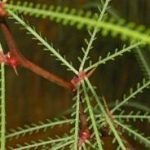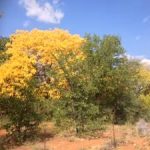TREE LIFE
April 2016
REMINDER: ANNUAL SUBS ARE DUE – if you would like to be able to vote at the AGM in May, please pay your $10 now (see payment details at the end).
MASHONALAND CALENDAR
Saturday 2nd April: Botanic Garden Walk. Meet at the car park at 0845 hours for 0900 hours.
Sunday 17th April: Jan van Bel has invited us to explore his little bit of heaven in the Domboshava Hills. Because of the nature of the venue he is unable to give us directions – there is quite a way to go through settled areas with many turn offs etc. and so he has suggested that we meet at CABS car park off Ridgeway North at 0830 hours for an 0845 departure. Bring all you need for a day in the bush: tea, lunch, chair, hat, water, sun cream, etc. There is a shelter there if it rains and a long drop loo, but no water, so bring enough water. This promises to be a very special outing. Jan has said that the road to the plot requires a high clearance vehicle.
Saturday 23rd April: Another special outing. We will be going to the home of Barbara Kockett at Mazowe Springs. She has kindly obtained permission for us to visit the Spring area – a very beautiful corner. We can walk there from her home. We will then have tea with Barbara and she has asked us to identify all the trees which have been planted in the complex, so a full and interesting afternoon ahead.
Notice of the Annual General Meeting of the Tree Society
Notice is hereby given that the 66th Annual General Meeting of the Tree Society of Zimbabwe will be held at the Education Centre, Mukuvisi Woodlands on Sunday 15th May 2016 at 9.30 am.
Any proposals/resolutions and nominations for office bearers (and any volunteers to be on the Committee) should be forwarded to the Secretary Teig Howson at teig.howson@gmail.com by Sunday 1st May if possible, although proposals and nominations will be accepted from the floor.
AGENDA
- Notice convening the meeting.
- Apologies.
- Minutes of the 65th A.G.M.
- Matters Arising.
- Chairman’s Report.
- Treasurer’s Report.
- Election of Committee Members.
- Any Other Business.
BOOK TO GIVE AWAY
A friend of Mark Hyde is leaving the country and she is happy to give her spare copy of Coates Palgrave 1983 to the first interested person. Please contact Mark by phone or email: mahyde@gmail.com.
Tree Society Web site
The committee has decided that the Tree Society web site needs to be modernised to give it a new look and make it more attractive. However the committee knows little about websites and so we are appealing to you, the members, for help. Have a look at the web site as it is now :
https://www.lind.org.zw/treesociety/index.htm
and make your suggestions to any Tree Society committee member.
What we would like to know: How should it look? What should be included on it? How should it work? Should there be links to any other website? Etc.
– Tony Alegria
PLANTED TREES OF HARARE Castanospermum australe
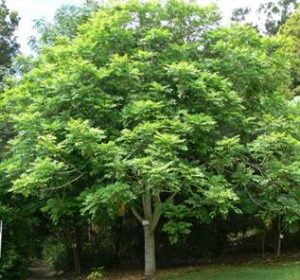
Castanospermum australe
Castanospermum australe, otherwise known as Moreton Bay Chestnut or Black bean, is the only species in the genus Castanospermum. It belongs to the Fabaceae family and is native to the eastern coastal rain forests of Australia and nearby islands. In Harare they are used as street trees and they are also grown in various gardens.
Castanospermum australe is a large evergreen tree growing up to 40 metres, but in Harare it is usually a lot smaller. The leaves are imparipinnate, being usually about 15 cm long and 6–7 cm wide, with 11-15 opposite or sub-opposite leaflets.
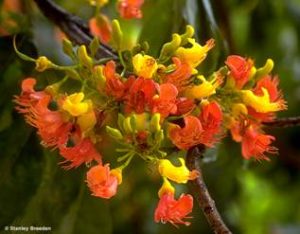
Castanospermum australe flowers
The flowers are bicoloured red and yellow, 3–4 cm long, produced in racemes about 6 cm long. The fruit is a large cylindrical pod, 12–20 cm long and 4–6 cm diameter. The interior is divided by a spongy substance into one to five cells, each of which contains a large chestnut-like seed.
The tree is grown for its attractive glossy pinnate leaves, which sometimes can reach 60cm, for its flowers and as a shade tree. It will flower in late spring, early summer, summer or late summer.
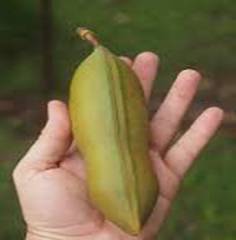
Castanospermum australe pods
The flowers from this plant are hermaphrodite (has both male and female organs) and they are pollinated by birds and insects. The orange or yellowish pea-shaped flowers are borne in clusters on the branches so that they are partially hidden by the leaves. It also makes an ideal indoor plant, especially as a baby plant with the ‘bean’ attached to its base. The ‘bean’ pod will naturally dry up and separate from the plant within several months and can be removed without any effect to the plant.
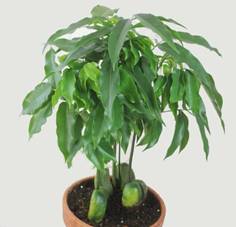
Castanospermum austral makes an ideal indoor plant.
Although the seeds are poisonous, they are made edible through a process that turns them into flour. The timber is soft, fine-grained and takes a good polish, but is not durable.
Sources:
Plants Rescue: Castanospermum australe. https://www.plantsrescue.com/castanospermum-australe/
Wikipedia: Castanospermum. https://en.wikipedia.org/wiki/Castanospermum
– Tony Alegria
Outing to Mountain View Farm 21st February 2016.
About 15 members braved the heat and were well rewarded with an excellent outing to Mountain View Farm, home of Tim, Ruth and Rebecca Kilner just the other side of Bindura on the Mazowe River. The Tree Society first went there in October 2014 when it was very hot and dry and leafless. This time was not much better – it was very hot, very dry but the trees did have leaves, and some had flowers.
Sadly we had arranged to leave Harare too late for such a long drive – I accept responsibility for that – but I have learned a good lesson. We only got to the farm at 10am and by the time we had done justice to the warm welcome, tea and iced water that Ruth and Rebecca had laid on for us, it was nearly 11am when we got into the field, and it was already very hot.
Rebecca had kindly worked out a route for us and we soon set off “treeing”, progress was at the usual Tree Society walk pace and by 12.30 hours most of us could only think of a cold beer/coke/juice waiting for us back at the house. We saw some interesting trees – see the list at end of this article – and Meg gave us, in her usual inimitable way, lots of information pertaining to each tree.
Sadly half the members had commitments back in Harare and after they had cooled off, some in the pool, they set off for home. The six of us remaining enjoyed another tree walk after the lunch break – Rebecca and Alan had worked out this for us.
Here, I must again say a huge thank you to Tim and Ruth for hosting us, for all the cold water and tea and the use of your lovely pool. We also need to say a big thank you to Rebecca and Alan for deciding where we should botanise and also to Alan for obtaining all the leaves needed for identification. Not only a mountain climber, Alan!!
Species seen at Mountain View Farm: Acacia polyacantha; Adenia gummifera; Brachystegia boehmii; Celtis africana; Combretum adenogonium; Dalbergia melanoxylon; Dichrostachys cinerea; Diospyros lycioides; Elaeodendron matabelicum; Euclea crispa; E. schimperi; Ficus sycomorus; Flacourtia indica (large spiny specimen); Flueggea virosa (Snowberry); Friesodielsia obovate; Grewia flavescens – flowering; Gymnosporia senegalensis (ex Maytenus senegalensis); Hoslundia opposita (herbaceous); Julbernardia globiflora; Lannea discolor; Leucaena leucocephala (not indigenous); Pavetta schumanniana; Pericopsis angolensis; Piliostigma thonningii – male flowers; Senna singueana; Steganotaenia araliacea; Strychnos spinosa; Terminalia mollis; T. sericea; T. stenostachya; Vernonia myriantha ; Ximenia americana
Some notes from the convener of Tree Society outings
Mountain View Farm has such a wealth of tree life and I felt really sad that we only scratched a few hundred metres along one of its roads. This was due, not only to the intense heat, but mainly because of the very late start from the meeting point. In future if we are going to be travelling some distance, we will meet at 0700 hours for a prompt 0715 hour start in order to make the most of our time out. We must be ready to move at the allotted time and not start wondering about who is going with whom. I feel sure that all those who were with us on Sunday feel deprived of some really good botanising. We are going to become early birds and have a full day’s pleasure in future. I hope you all agree.
– Mary Lovemore
Botanic Garden Walk – 5th March 2016
We had a delightful walk in the Botanic Garden on the morning of 5th March. We – Dave, Chris, Rob, Patch, Sarah, Richard, Barbara and myself – were joined by Vera Neil, a name from the past in the Tree Society. The Garden is looking very green after the recent rain and the old tractor (from long ago days) was busy mowing. It was really good that Chris Chapano was able to join us and he provided all sorts of useful information.
We walked out past the tea room towards St Georges College and, apart from all the other species remarked upon. was Markhamia obtusifolia, Golden Bellbean, with its bright yellow flowers. It is described in van Wyk as a shrub to small bushy tree – well this one must have been well placed as it has grown to be a big tree! Then we passed Ficus trichopoda and Burrtdavya nyassica (not indigenous to our region, but spectacular). The Oncoba spinosa, and whose name is now Xylotheca kraussiana, fried egg flower or snuff box tree was in full fruit and one could easily see how the fruits are used as snuff boxes – a bit old fashioned maybe nowadays. There was discussion about Ficus capreifolia, sand paper fig, not in the same class as Commiphora mollis when stranded in the bush!! The leaves and fruit are often heavily parasitized by gall forming insects and are larval food for the hawk moths Pseudoclanis postica and Nephele accentifera.
The Cordyla africana was in full fruit and had many germinating babies around it. They have done so well in the Garden. The last time I was in the Garden the Lonchocarpus capassa, now Philenoptera violacea was flowering and we were “rained” on by the watery excretions of the sap-sucking nymphs Ptyelus grossus (Hemiptera). The butterflies Charaxes bohemani and Coeliades forestan forestan breed on the tree.
Then we had a look at a very tatty Acacia tortilis and Chris told us that this tree had “caught” all sorts of birds with its spiky thorns including Purple crested Turacos, doves, bulbuls and blue waxbill!
We looked at Commiphora merkeri, or Commiphora viminea, zebra bark, and Commiphora caerulea – blue bark Commiphora or blue bark corkwood. We had to admire Chorisia speciosa, Kapok/ Orchid Tree/ Silk Cotton Tree, which has been spectacular all around town this year.
Altogether a delightful walk with very pleasant company and it is amazing how quickly time passes when you are having fun. Thank you to Dave and Chris for all your input, please join us again Chris.
– Mary Lovemore
Here is a very interesting article by the late Dick Petheram, first posted in Tree Life 95, January 1988. Note that many of the botanical names have been changed since then – I have only highlighted a couple. If this is an interest of yours, see how many you can change and let me know.
-Ed
WILD ANIMALS AND BROWSE TREES
This is a subject of which I claim no expertise, so it is probably an excellent one on which to launch a short thesis. All letters of outrage should be addressed to the Chairman. He, it was, who invited me to write it.
In the course of camping expeditions, even those in which the dietary preferences of fish may be of more immediate concern than the feeding habits of game, one‘s joy in ones surroundings is enhanced immeasurably by the presence of wild animals and birds. The over-riding reason for resisting the temptation to give voice to frustration when the fish are uncooperative, is that it would be unforgivable to rupture the atmosphere of serenity in which birds accept one’s intrusion or in which a shy antelope, or squirrel, or leguaan, or even a croc might suddenly materialise as if a magician had waved a wand. Such expeditions, and others more specifically planned for game-viewing, leave one with an ever-mounting interest in both the habitat and the habits of wild life. If, for example, one has yearning to see giraffe in numbers, a trip to Hwange National Park can be most rewarding. Our giraffes are in their element on the Kalahari sandveld of the Hwange National Park, among their beloved erioloba trees (previously called (far more appropriately to the animal lover A. giraffae) and show no desire to migrate to the Mana Pools environment.
In another context, one tends to find that while Brachystegia species are not highly prized as preferential browse, at least in some areas, many trees and grasses associated with Brachystegia woodlands are well utilised by browsers and grazers respectively.
But these are random thoughts, merely to make the point that the study of browse preferences can add immensely to the fascination of trees, as well as of animals. I would venture the opinion that among the most utilised browse plants, judging by the frequency with which they are singled out for mention in authoritative works on the subject, are the following 30 to 35, well known to us.
- a) Leguminous plants as a whole — their high protein value derived, possibly, from nitrogen fixation by root nodule bacteria – and, within that family the genus Acacia, with tortilis and A. karroo getting high marks. Also the legumes Bauhinia thonningii, Burkea africana, Colophospermum mopane, Dalbergia melanoxylon, Dichrostachys cinerea, Lonchocarpus capassa, Pterocarpus rotundifolius, and Schotia brachypetala.
- b) Combretaceae – prominent amongst them Combretum apiculatum, C. collinum, C. hereroense, C. molle, and C. zeyheri.
2. Other:
Bequaertiodendron magalismontanum [now Englerophytum magalismontanum – Ed], Bridelia mollis, Capparis tomentosa, Diplorhynchus condylocarpon, Euclea divinorum, Grewia flavescens, Kirkia acuminata, Maytenus heterophylla, Mimusops zeyheri, Pseudolachnostylis maprouneifolia, Strychnos spinosa, Boscia spp., Diospyros spp, Ficus spp. (all fruit in the main but leaf browse also to some extent), Lannea spp, specially the fruit of the ground hugging L. edulis, Syzygium cordatum, Terminalia sericea, Ziziphus mucronata.
This list could easily be doubled or trebled. My selection has been a trifle arbitrary, but not blindly so. An essay in greater depth would take into account the fact that one researcher in the 70s recorded 87 browse plants (and 42 grasses and 36 herbs) on which elephants live; that studies in East Africa indicated that some 200 species of plant were browsed by black rhino; that in the Kruger National Park 148 species have been associated with kudu as browse; that eland are reputed to eat just about any plant under the sun, depending on availability and seasonal needs (Smithers, 1983).
A generalisation which is fairly widely accepted, I think, is that just as termite mounds are the richest source of plant variety in the veld, so too do animals prefer to browse on the plants thereon, presumably because of their more highly mineralised content. Incidentally animals which are predominantly browsers do, occasionally, graze and grazers are known to browse some of the time. The little steenbok nibbles leaves and grasses with equal enthusiasm, the proportion varying with the habitat. The grysbok is said to be similarly inclined. Impala are also partial to both browse and grass and, as shown above, elephants also believe in variety. Subject to these observations, animals which are categorised as predominantly browsers include black rhino, giraffe, duiker klipspringer, kudu, nyala, bushbuck and eland.
The grazers (again remembering a tendency by some of them, quite frequently, to browse) included zebra, blue wildebeest, tsessebe, oribi, roan antelope, sable antelope, gemsbok, buffalo, reedbuck, waterbuck, hartebeest, square-lipped rhino, hippo and warthog.
On the 10th November the Chairman and Maureen and I travelled to Mr John Becks‘ farm “Chelvey” by invitation, to chat to him and to other members of the Bindura Wild Life Society about browse vegetation. The members of the Society appear to be drawn from the Bindura, Matepatepa and Shamva areas. It is chaired by Mr Ian Taylor of Imsingisi Farm. Some of the members have stocked, or are in the process of stocking, game procured from the Dept. of National Parks and Wildlife Management. In John’s case wildebeest and impala have been introduced to supplement the kudu and sable that are resident in the area. John and Wendy made us feel immediately at home and we were most cordially welcomed to the gathering also by Ian (in the chair), and by other members of the group who arrived for the meeting.
We found the chat stimulating – as we hoped our hosts did – and we would have liked time to explore the area more thoroughly. We had time to take in only 48 tree and shrub species. These we saw in the boma (a spacious and well wooded enclosure) and in the course of two foot patrols along a 150 metre gwasha fringe, as well as while travelling by truck along a track bisecting the game area. Almost 70% of the trees were browse trees, as indicated with a * below:
Acacia amythethophylla*; A. polyacantha*; A. rehmanniana*; A. sieberiana*; Acokanthera oppositifolia*; Bauhinia petersiana *; thonningii*; Brachystegia boehmii*; B. spiciformis ; Combretum erythrophyllum*; Combretum fragrans*; C. hereroense *; C. mole; Dichrostachys cinerea*; Diospyros lycioides*; Diplorhynchus condylocarpon* Dombeya rotundifolia*; Ekebergia capensis*; Euclea divinorum*; Faurea speciosa *; Ficus sur; Julbernardia globiflora; Lannea discolor*; L. edulis*; Maytenus heterophylla*; [Maytenus has been renamed Gymnosporia, this one is now G. buxifolia – Ed]; M. senegalensis*; Myrica serrata; Pseudolachnostylis maprouneifolia*; Peltophorum africanum*; Pericopsis angolensis; Protea gaguedi (emphasis on birds)*; Pterocarpus angolensis *; Pterolobium stellatum; P. quartiniana; Rhus longipes; Salix subserrata*; Securidaca longipedunculata*; Securinega virosa*; Terminalia sericea*; T. stenostachya*; Vangueriopsis lanciflora* (emphasis on birds); Ximenia caffra*; Ziziphus mucronata*
The Ekebergia trees were outstanding, without doubt the most imposing of all in the riverine area and within the boma was the most splendid Ximenia caffra imaginable – some 25 feet tall and full of almost mature fruit. Another fine specimen of the same tree was growing within the inner stockade.
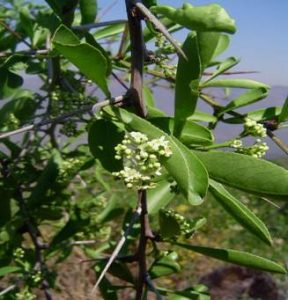
Gymnosporia buxifolia [ex Maytenus heterophylla] Photo: Flora of Zimbabwe.
Note was taken at our meeting of the fact that some fruit pods are toxic when unripe; some bark, some sap, and some roots are used as poisons by man; even some seemingly innocuous plants are said to employ a defensive mechanism (e.g. when in danger of being over-browsed) whereby repellent chemical substances are produced or increased in foliage or elsewhere.
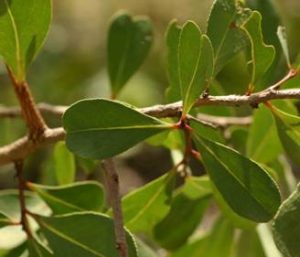
Gymnosporia senegalensis [ex Maytenus senegalensis] Photo: Flora of Zimbabwe.
Reference: SMITHERS, R. H. N., 1983. The Mammals of the Southern African Subregion. Pretoria: University of Pretoria.
– R.W.Petheram
TONY ALEGRIA


